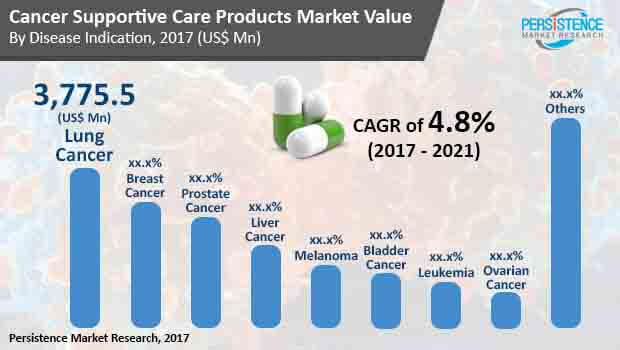Cancer Supportive Care Products Market Segmented By Lung Cancer, Breast Cancer, Prostate Cancer, Liver Cancer, Bladder Cancer, Leukaemia, Ovarian Cancer, Melanoma Indication with Nonsteroidal Anti-inflammatory Drugs, Anti-infective, Anti-emetics, Monoclonal Antibodies, Erythropoietin Stimulating Agents, Opioid Analgesics, Bisphosphonates Drugs
Industry: Healthcare
Published Date: March-2018
Format: PPT*, PDF, EXCEL
Delivery Timelines: Contact Sales
Number of Pages: 212
Report ID: PMRREP5336
According to the World Cancer Research Fund International (WCRF), there will be more than 24 million cancer cases of cancer across the world by the year 2035, and the figures do not include non-melanoma skin cancer. Within the developed country of the U.S., according to the National Cancer Institute (NIH), there were more than a million and half new cases of cancer in the year 2017.
Owing to this strong and expanding prevalence of cancer, a number of healthcare organizations have thrown their hat into it and the demand for the products that support cancer care is expanding radically. According to this business intelligence study, the demand in the global cancer supportive care products market will multiply at a CAGR of 4.8% during the forecast period of 2017 to 2021.
Revenue-wise, the analysts of the report have estimated that the opportunities in the cancer supportive care products market across the world will translate into a revenue of US$ 31,700.0 Mn by the end of 2021, significantly more than the market’s evaluated worth of US$ 26,285.5 Mn in 2017.
Apart from the growing pervasiveness of cancer, which has attracted the attention of several organizations and governments alike, the global cancer supportive care products market is driven by several other factors. Some of them include: increasing percentage of geriatric population across the world, greater effectiveness of anti-cancer treatments, increased purchasing power of urban population in emerging economies, and product innovation.
On the other hand, entry of biosimilars, extremely high cost of research and development practices, and regulatory barriers are a few restraints challenging the market from flourishing. Nevertheless, the vendors of the cancer supportive care products market are expected to gain new opportunities in the vastly populated emerging economies of Asia Pacific and by increasing their investments in R&D activities.
Based on drug class, this report segments the market for cancer supportive care products into opioid analgesics, nonsteroidal erythropoietin stimulating agents, anti-infective drugs, anti-imflammatory drugs, bisphosphonates, monoclonal antibodies, anti-emetics drugs, and granulocyte colony stimulating factor. Among these, the segments of erythropoietin stimulating agents and granulocyte colony stimulating factor are projected to provide for the maximum chunk of demand at 25.0% and 20.2% respectively by the end of 2021.
Indication-wise, the cancer supportive care products market has been bifurcated into lung cancer, prostate cancer, breast cancer, ovarian cancer, leukemia, bladder cancer, liver cancer, melanoma, and others. By the end of the year 2021, the others segment is poised to be most profitable, but that will be distributed among various types of cancer. Individually, lung cancer and breast cancer are the two key segments, primed to provide for a demand percentage of 14.8% and 13.6% respectively by 2021.
Initiatives by several governments to increase awareness regarding lung and breast cancer is expected to drive growth of these two segments. On the basis of distribution channel, the report segments the market into hospital pharmacies, compounding pharmacies, and retail pharmacies.

Geographically, North America dominates the demand in the global cancer supportive care products market. By the end of 2021, the region of North America, backed by the developed country of the U.S., is poised to provide for a demand share of 44.2%, followed by the vastly populated Asia Pacific region at 24.7%.
While North America has a robust healthcare infrastructure and high rate of adoption of new technology, Asia Pacific hosts two of the most promising emerging economies – China and India – where disposable income is rapidly increasing among the urban population.
To know more about delivery timeline for this report Contact Sales
